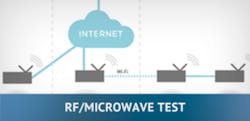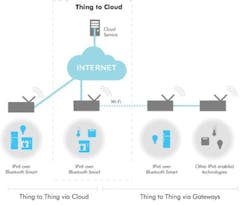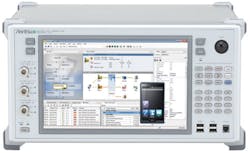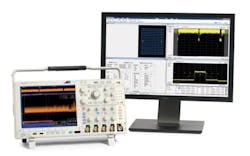Internet of Things boosts measurement challenges
The Internet of Things (IoT) is upon us. According to Gartner, 4.9 billion connected “things” will be in use this year, with the number reaching 25 billion in 2020. The market-research firm said last fall that IoT has become a force for business transformation that will have a disruptive impact across all industries, affecting consumers, businesses, city authorities, hospitals, and other entities. Consumer applications will drive unit volumes (Table 1) while enterprises will account for most of the revenue. Gartner, which offers several research documents on the topic, expects that the IoT will support total services spending of $69.5 billion in 2015 and $263 billion by 2020.
Source: Gartner (November 2014)
The overwhelming majority of these “things” will have wireless connectivity—such as Bluetooth, Wi-Fi, ZigBee, or cellular—and in fact, many will operate at multiple frequencies and support multiple generations of standards to provide communications worldwide. To complicate test, these heterogeneous devices include analog and digital circuitry as well as RF.
And while each IoT device may not require high bandwidths, latency may be important in some applications. Further, the proliferation of the devices will result in massive amounts of data that wireless infrastructure must handle. 5G will have a role to play, but billions of connected devices will be deployed long before 5G rolls out.
Thing-to-thing and thing-to-cloud
Nordic Semiconductor, a maker of low-power SoC devices, sees a role for Bluetooth Smart in large, distributed, cloud-connected heterogeneous networks serving home, industrial, and enterprise automation applications (Figure 1). The company showcased its nRF51 IoT Software Development Kit (SDK) and demonstrated IPv6 over Bluetooth Smart at the Mobile World Congress in March in Barcelona. Nordic’s IPv6 over Bluetooth Smart protocol stack for its nRF51 Series SoCs facilitates small, low-cost, ultralow-power IoT applications. The nRF51 IoT SDK is a complete IPv6-ready Internet protocol suite for the nRF51 Series Bluetooth Smart SoCs. The SDK enables native and interoperable IP-based connectivity between a Bluetooth Smart “thing” and a cloud service.
Courtesy of Nordic Semiconductor
Bluetooth Smart is only one part of the wireless connectivity picture. “It is widely understood that the IoT is literally introducing billions of wireless devices that use technologies ranging from Bluetooth to Wi-Fi to LTE, and of course ZigBee,” said David Hall, principal product manager for RF test systems at National Instruments. “Given the rising number and complexity of today’s wireless standards, IoT devices must support an increasing number of wireless interfaces to be commercially viable.”
IoT test and measurement challenges
That, in turn, poses test and measurement challenges. “Not only does the addition of RF test add significant manufacturing costs to devices with new wireless connectivity,” said Hall, “but rising wireless complexity is increasing the sheer number of measurements a tester must perform to validate the device’s wireless capability. Because test cost is largely a function of test time, more RF measurements translate to higher test cost in the absence of a better test solution.”
Continued Hall, “NI’s strategy for testing the IoT is to provide a wireless test solution that dramatically lowers test cost through significant improvements in measurement speed. Not only does our solution leverage parallel test techniques and advanced CPU/FPGA technologies to deliver industry-leading test speed, but it does so with a modular approach that can be updated and upgraded to support new wireless standards and leverage future computing technologies. In the end, we’re building production test systems based on modular hardware and scalable software that will drastically break the traditional cost paradigm and give organizations new options for testing IoT devices.”
Rohde & Schwarz also is addressing IoT applications. “The Internet of Things is driving a lot of people into uncomfortable measurement spaces,” said Scott Bausback, president and CEO of Rohde & Schwarz USA, in an interview1 at DesignCon in January. “That’s where we come into play. We can be the industry consultant or professor to help customers get their designs out the door. Our applications engineers are an important commodity.”
At the Mobile World Congress in March, the company exhibited a system consisting of an R&S SMW200A vector signal generator and an R&S FSW signal and spectrum analyzer in combination with an R&S RTO oscilloscope. When equipped with the R&S FSW-B2000 option, the R&S FSW provides an analysis bandwidth of 2 GHz. The system presented at the show can perform tests that help meet the demand for higher data rates and capacity resulting from the rapid rise in the number of devices and machines that communicate using M2M and IoT architectures. The company also said research is underway on a 5G wireless protective bubble for pedestrians—a vehicle penetrating this bubble would brake automatically—an application imposing strict demands on networks with respect to latency.
Nonsignaling vs. signaling
Craig Hendricks, senior wireless business development manager at Anritsu, zeroed in on a specific technique that can cut test costs. “For some devices, the cost of test can be lowered by using chipset-specific control to test in nonsignaling or direct mode,” he said. “This reduces both test time and the cost of the test equipment but requires licensing or cooperation with the chipset manufacturer, which is why Anritsu works closely with key customers. If access to this interface is not available, the RF tests have to be done using the same signaling or network mode as used by the device in the real world.” This last can be accomplished using the MD8475A signaling tester (Figure 2), which has an easy-to-use SmartStudio interactive user interface. With SmartStudio, Hendricks said, engineers can conduct many tests that previously required creating scripts with detailed knowledge of the protocol. For both design and production environments, he added, MD8475A enables system-level support for test of data throughput, handover, SMS (text and binary), VoLTE, and power consumption, and it supports application testing of devices connected to the Internet and servers used in the live network.
Courtesy of Anritsu
In addition, Hendricks said, “We offer a wide range of test solutions for the development of IoT devices and systems at all stages. The MT8870A Universal Wireless Test Set, which has 160 MHz of bandwidth and covers frequencies from 10 MHz to 6 GHz, can conduct TX and RX RF testing in nonsignaling mode for a variety of technologies, including cellular, Bluetooth, Wi-Fi, ZigBee, and GPS. Designed for product development and production, the MT8870A can test up to four devices simultaneously with up to four fully independent modules.”
Hendricks cited several other instruments that can serve in IoT test applications, including the MS2830A spectrum/signal analyzer, which can support cellular, Bluetooth, and Wi-Fi test; the MT8852B Bluetooth Test Set, which offers signaling and nonsignaling test and supports the Data Length Extension associated with Bluetooth Low Energy (BLE) as part of Bluetooth Core Specification version 4.2; and the MT8860C WLAN Test Set, an integrated one-box solution that can test 802.11a/b/g Wi-Fi RF TX and RX in signaling mode.
Time and frequency analysis
Dorine Gurney, source and analyzer product planner at Tektronix, said her company has been enhancing its RF analysis portfolio to help companies offering IoT products perform the testing and debugging necessary for the integration of RF features, which, she emphasized, can be very costly. The company’s instrument portfolio includes mixed-domain oscilloscopes; oscilloscopes that also include logic analyzers, spectrum analyzers, and protocol analyzers; and a new RSA306 USB real-time full-featured spectrum analyzer that is affordable and portable.
The RSA306, she elaborated, is used onsite to capture the RF environment and determine why network infrastructure is not responding properly and why an integrated RF device is not performing as expected, resulting in data rates dropping. In addition, she said, “Our MSO70000 Series high-performance oscilloscopes equipped with vector-signal-analysis SignalVu software can trigger on RF interferences caused by high-speed serial buses used in the design. Our benchtop RSA5000B real-time spectrum analyzers help find and analyze EMI compliance issues and determine why the semiconductor device is failing compliance testing. Our AWG70000 Series is used in the creation of an adverse RF environment needed to bombard RF devices to improve their robustness to interference and their adaptation algorithms.”
She added, “We also have a strong portfolio of real-time RF test solutions for RFIC manufacturers and module makers to help them with performance testing.” In fact, she said, “Tektronix offers solutions for all the players of the industry: RF IC manufacturers and module makers like Broadcom or Silicon Labs, infrastructure system companies like Cisco or Netgear, as well as the many companies designing consumer products for the IoT—from medical applications to smart beds.”
Modular and benchtop instruments
Keysight Technologies also addresses IoT. “Keysight continues to broaden its range of solutions for all the technologies coming forward for IoT and 5G,” said Jan Whitacre, mainstream wireless technology lead at the company. “Our high-performance solutions provide the engineer the choice of modular or benchtop [instruments] with application software that solves their specific problems. We are focused on testing RF components, chipsets and devices, and the digital components that make up the network for cloud computing. Keysight’s goal is to give engineers the insight they need to meet their design goals and schedules.”
Whitacre continued, “Keysight is the only test and measurement company that offers both modular and benchtop solutions along with powerful software.” Keysight, she said, delivers software for signal generation and analysis for the key technologies being used in the IoT, including 802.11a/b/g/j/p/n/ac/ah, Bluetooth, NFC, ZigBee, Wi-SUN, and cellular technologies.
“Keysight,” she said, “is focused from early design simulation using our EDA tools to R&D, system validation and integration, manufacturing, conformance, installation, and service and maintenance.”
Specific products, she said, include the EXM Wireless test set and the V9077B WLAN Measurement Application, which combine to deliver the speed, accuracy, and port density necessary to ramp up production rapidly and optimize full-volume manufacturing.
From PXI modules to systems
Hall at National Instruments said NI offers a range of products to address customer needs from initial design through high-volume manufacturing test. “For example,” he said, “many of our customers automate PXI test equipment to improve design-validation efficiency of both semiconductor and wireless devices. In these applications, instruments such as the NI PXIe-5668R 26.5-GHz RF signal analyzer and NI PXIe-4139 source-measure unit (SMU) provide the superior analog performance that is now required to test today’s analog ICs.”
He continued, “In addition to modular PXI instruments, NI also offers solutions that provide a software experience and physical ruggedness to meet the requirements of high-volume manufacturing test.” These solutions use PXI internally but add features necessary for a given application. “For example,” he said, the Semiconductor Test System (STS) supports native integration of handler and probing systems and can be programmed with customized software.”
Hall added, “Our newest product for manufacturing test is the Wireless Test System (WTS), which combines NI vector signal transceiver technology with a software offering that’s specifically designed for high-volume wireless manufacturing test. One of the unique elements of this solution is the TestStand Wireless Test Module, a software package that incorporates NI’s industry-leading test executive software with plug-ins for specific wireless chipsets from Qualcomm and Broadcom.”
While many large test companies offer a broad instrument portfolio, Signal Hound focuses on low-cost spectrum analyzers. “Many smaller companies that are developing and/or manufacturing IoT devices will be pleased to know that there is a low-cost real-time RF spectrum analyzer available that comes standard with digital modulation analysis tools,” said Bruce Devine, Signal Hound’s CEO. By the May International Microwave Symposium in Phoenix, he said, Signal Hound will have unveiled its newest free software upgrade for the BB60C spectrum analyzer. The new Digital Modulation Analysis tools will include support for constellation diagrams, EVM measurements, symbol tables, a gray-code handler, I/Q inversion, and bit/symbol pattern recognition for formats of O-QPSK, QPSK, BPSK, 8PSK, π/4DQPSK, 8DPSK, DQPSK, and QAM16.
“Zigbee, Bluetooth, and Wi-Fi are some of the wireless formats with IoT test applications that can benefit now from these tools,” Devine said. “IoT devices using sub-1-GHz wireless will have modulation analysis tools added later this year to include formats of FSK, GFSK, OOK, ASK, MSK, and GMSK. “
Beyond RF connectivity
There is more to the IoT than RF/wireless connectivity as IoT devices incorporate analog and digital circuitry as well. “Debugging such complex designs is a difficult and somewhat daunting task to the engineer who is only armed with his favorite four-channel oscilloscope,” said Gurney at Tektronix. “Many engineers feel comfortable with their oscilloscope. Logic analyzers provide the ability to probe many digital signals, but the complexity of the debug task may not merit the cost and learning curve required to use the logic analyzer. Similarly, engineers liked to add a spectrum analyzer to their bench. However, spectrum analyzers may not be intuitive for engineers used to time-domain analysis.” The company’s MDO3000 and MDO4000B Series oscilloscopes (Figure 3) offer an alternative to multiple time-, logic-, and frequency-domain instruments, incorporating spectrum-analyzer and logic-analyzer functionality in a single instrument.
Courtesy of Tektronix
National Instruments takes a modular approach to testing complex RF/mixed-signal devices. “The increasing complexity of mixed-signal wireless devices requires test engineers to use a range of test equipment,” said Hall at NI. “Historically, engineers solved this test challenge through the use of multiple discrete instruments, with each instrument testing a single function. Today, NI solves this challenge through a modular platform that allows test engineers to combine various types of mixed-signal I/O into a single test system. Not only are modular instrumentation systems more maintainable, but they’re also able to address additional test requirements such as instrument timing and synchronization.”
Whitacre at Keysight cited still other issues: battery life will be a significant factor, as will EMI/EMC. With regard to the latter, she said, “As more wireless technologies are deployed, there are more issues of dealing with unwanted signals from spurious emissions and intermodulation products. These must be dealt with to ensure reliability of the device’s operation in critical environments such as medical monitors or a car that is being remotely controlled.”
In addition, she said, “IoT requires high-speed-digital (HSD) for cloud computing to enable central IoT networks.” And, she added, it needs material characterization for the smaller sensors, components, SoCs, and MEMS devices that make IoT possible. “Keysight has high-speed digital and component-characterizing solutions that can solve customers’ test challenges in each of these areas,” she concluded.
REFERENCE
1. Nelson, R., “Microwave issues affect communications test,”
EE-Evaluation Engineering, April 2015, p. 32.
FOR MORE INFORMATION




